AMD Reveals Polaris GPU Architecture: 4th Gen GCN to Arrive In Mid-2016
by Ryan Smith on January 4, 2016 9:00 AM ESTPolaris: What’s In a Name?
One area where AMD/RTG struggled quite a bit with their existing Graphics Core Next GPUs has been on giving the press and the public consistent and meaningful architecture names. The matter of product naming has always encompassed a certain degree of strife, as a single product can have multiple names: an architecture name, a retail name, a development name, etc. Coupled with the fact that not all of these names are meant to be used in the public, and a certain need to avoid calling attention to architectural differences in what consumers are supposed to perceive as a homogenous product line, and it can quickly become a confusing mess.
Thankfully for Polaris, RTG is revising their naming policies in order to present a clearer technical message about the architecture. Beginning with Polaris, RTG will be using Polaris as something of an umbrella architecture name – what RTG calls a macro-architecture – meant to encompass several aspects of the GPU. The end result is that the Polaris architecture name isn’t all that far removed from what would traditionally be the development family codenames (e.g. Evergreen, Southern Islands, etc), but with any luck we should be seeing more consistent messaging from RTG and we can avoid needing to create unofficial version numbers to try to communicate the architecture.
To that end the Polaris architecture will encompass a few things: the fourth generation Graphics Core Next core architecture, RTG's updated display and video encode/blocks, and the next generation of RTG's memory and power controllers. Each of these blocks is considered a seperate IP by RTG, and as a result they can and do mix and match various versions of these blocks across different GPUs, such as the GCN 1.2 based Fiji containing an HEVC decoder but not the GCN 1.2 based Tonga. This, consequently, is part of the reason why AMD has always been slightly uneasy about our unofficial naming. What remains to be seen then is how (if at all) RTG goes about communicating any changes should they update any of these blocks on future parts, and whether say a smaller update like a new video decoder would warrant a new architecture name.
As for the Polaris name itself, RTG tells us that Polaris was chosen as a nod to photons, and ultimately energy efficiency. Though it’s not clear right now what the individual GPUs will be named (if they get names at all), but given the number of stars in the universe RTG certainly isn’t at risk of running out of codenames in the near future.
The Polaris Architecture: At A High Level
As I briefly mentioned a bit earlier in this article, today’s reveal from RTG is not meant to be a deep dive into Polaris, fourth generation GCN, or any other aspect of RTG’s architecture. Rather today is meant to offer a very high level overview of RTG’s architectural and development plans – similar to what we traditionally get from Intel and NVIDIA – with more information to come at a later date. So it’s fair to say that today’s reveal won’t answer many of the major questions regarding the architecture, but it gives us the briefest of hints of what we’ll be talking about in depth here later this year.
The Polaris architecture encompasses several different RTG technologies, and with a focus on energy efficiency RTG claims that this will be largest jump in performance per watt in the history of Radeon GPUs. At its heart is RTG’s fourth generation Graphics Core Next architecture, which despite the generational naming is easily the biggest change to RTG’s shader core architecture since the launch of first generation of GCN GPUs in 2012. Officially RTG has not assigned a short-form name to this architecture at this time, but as reading the 8-syllable “fourth generation GCN” name will get silly rather quickly, for now I’m going to call it GCN 4.
For GCN 4, RTG will be making a number of changes in order to improve the efficiency of the architecture from both a throughput perspective and a power perspective. Of the few details revealed to us, one of the things we have been reassured of is that GCN 4 is still very much Graphics Core Next. I expect that means retaining the current 16-wide vector SIMD as the base element of the architecture, in which case it should be fair to say that while GCN 4 is the biggest change to GCN since its introduction, RTG is further building on top of GCN rather than throwing large parts out.
RTG’s few comments, though obviously made at a very high level, offer a good deal of insight on where we should expect GCN 4 to go from a throughput perspective. Overall RTG packs quite a bit of hardware into their GCN GPUs, with Fiji reaching 4096 FP32 stream processors, however putting all of those SPs to good use has been difficult for RTG. This is something we’ve seen first-hand over the last year, as the Radeon Fury ended up being surprisingly close to the Fury X in performance despite the difference in SP counts. Similarly, the recent launch of DirectX 12 and the first uses of asynchronous shading have shown that RTG’s architectures at times significantly benefit from the technology, which is an indicator that they haven't always been able to fill up their SPs with work under normal circumstances.
As a result a lot of the disclosed GCN 4 key features point to improving throughput of GCN. Improved shader efficiency is somewhat self-explanatory in that regard. At the same time RTG is also disclosing that we will be seeing some kind of hardware scheduler in GCN 4 along with instruction pre-fetch capabilities, which again should help them improve throughput in ways to be determined. Meanwhile in an improvement for the GPU front-end, GCN 4 will be adding a primitive discard accelerator – and again we don’t have any further details than this – but it should help the architecture clamp down on getting rid of unseen geometry. Finally, GCN 4 will also include a newer generation of RTG’s memory compression technology, this coming just one generation after it was most recently (and significantly) improved for the third generation GCN architecture (GCN 1.2).
What isn’t mentioned in RTG’s key features for GCN 4 but is clearly a major aspect of the core architecture’s design is energy efficiency. While RTG will be drawing a significant amount of their energy efficiency gains from the switch to FinFET (more on this in a bit), the architecture will also play a large role here. RTG was upfront in telling us that on average the node shrink will probably count for more of Polaris's gains than architecture improvements, but this will also be very workload dependent. In order to make that happen the architecture team has been spending quite a bit of time on the matter, analyzing and simulating different workloads and architecture options to find ways to improve the architecture. Truthfully I’m not really sure how much of this will ever be disclosed by RTG – energy efficiency is very much the secret sauce of the GPU industry these days – but hopefully we’ll get to find out more about what kind of energy optimizations GCN 4 includes closer to the launch of the first GPUs.
Meanwhile along with the improvements coming courtesy of GCN 4, Polaris also encompasses RTG’s updated display and multimedia capabilities. As we covered the display tech last month I won’t dwell on that too much here, but suffice it to say Polaris includes a new display controller that will support the latest DisplayPort and HDMI standards.
Finally, along with today’s announcement RTG is also disclosing a bit of what we can expect for Polaris’s multimedia controllers. On the decode side RTG has confirmed that Polaris will include an even more capable video decoder than Fiji; along with existing format support for 8-bit HEVC Main profile content, Polaris’s decoder will support 10-bit HEVC Main10 profile content. This goes hand-in-hand with the earlier visual technologies announcement, as 10-bit encoding will be necessary to prevent banding and other artifacts with the wider color spaces being used for HDR. Meanwhile RTG’s UVD video encode block has also been updated, and HEVC encoding at up to 4K@60fps will now be supported, marking a major jump over the previous generation encoder block only supporting H.264. There is no word on whether that will include Main10 support as well, however.
Polaris Hardware: GDDR5 & HBM
Although not a part of RTG’s presentation, along with the architecture itself we also learned a few items of note about RTG’s hardware plans that I wanted to mention here.
First and foremost, Polaris will encompass both GDDR5 and High Bandwidth Memory (HBM) products. Where the line will be drawn has not been disclosed, but keeping in mind that HBM is still a newer technology, it’s reasonable to expect that we’ll only see HBM on higher-end parts. Meanwhile the rest of the Polaris lineup will continue to use GDDR5, something that is not surprising given the lesser bandwidth needs of lower-end parts and the greater cost sensitivity.
Meanwhile RTG has also disclosed that the first Polaris parts are GDDR5 based. Going hand-in-hand with what I mentioned earlier about RTG’s Polaris demonstration, it seems likely that this means we’ll see the lower-end Polaris parts first, with high-end parts to follow.
As for the specific laptop and desktop markets, RTG tells us that desktop and mobile Polaris parts will launch close together. I wouldn’t be surprised if mobile is RTG’s primary focus since it’s already the majority of PC sales, but even so desktop users shouldn’t be far behind.


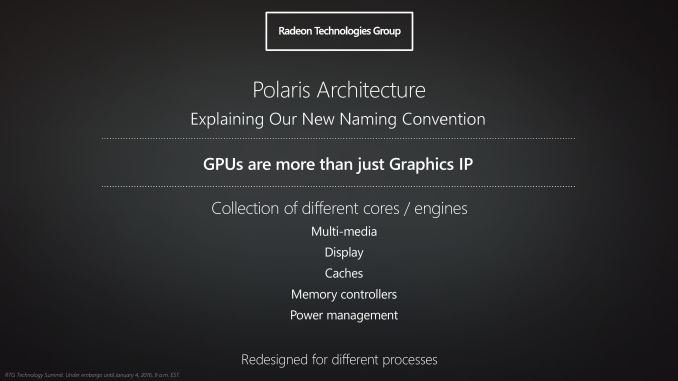
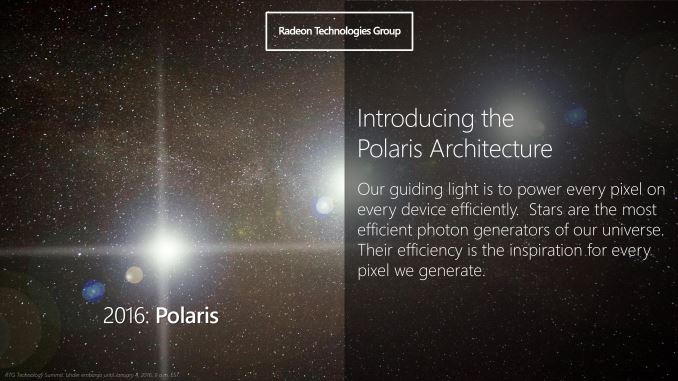
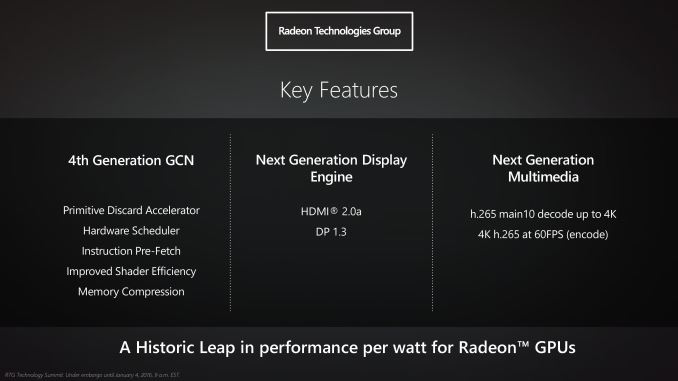
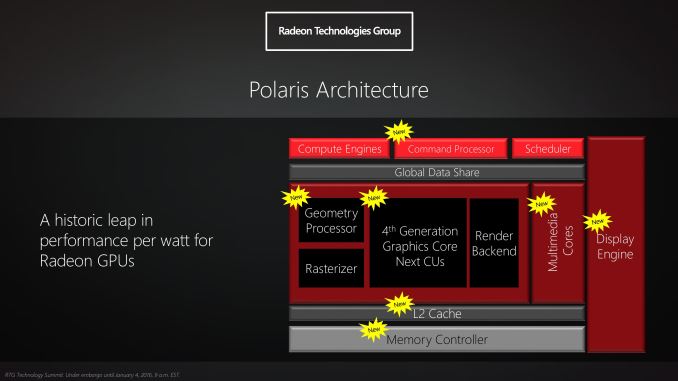
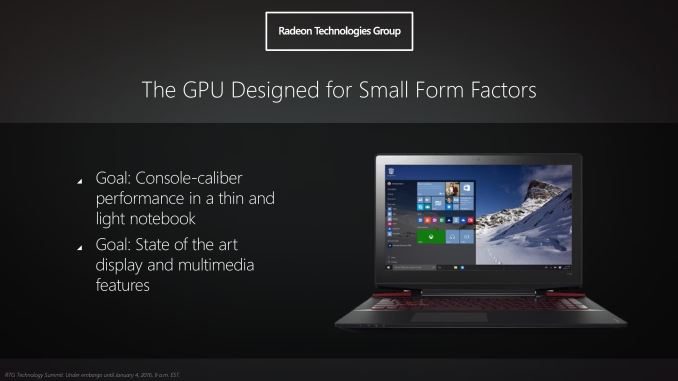








153 Comments
View All Comments
Cinnabuns - Monday, January 4, 2016 - link
Power:performance translates into $:performance if you're the one footing the utility bill.nikaldro - Tuesday, January 5, 2016 - link
This is a common myth. Unless your PC drinks A LOT of Watts, your power bill won't change much.HollyDOL - Tuesday, January 5, 2016 - link
Depends where you live (cost per MWh), how long do you run the PC and how loaded it is... It ain't that hard to calculate... where I live I pay ~ 62Eur per MWh (75 with tax)... so running 600W power hog vs 300W 8 hours a day (wife@home, so prolly it's even more) puts you on 108 vs 54 Eur a year (plus tax) on computer alone. It's not tragic, but also not that little to just plain neglect it...Peter2k - Monday, January 4, 2016 - link
Because AMD runs too hot to be cooled easily compared to NVidiaWell high end cards anyway
Less heat = less noise/or more frequency (=more performance)
Ramon Zarat - Monday, January 4, 2016 - link
Thanks to the destruction of the middle class, the erosion of purchasing power and price rise of all sources of energy in the last 40 years, the Watt per frame equation is actually more important than ever. Unless you are part of the privileged 1% and wipe your ass with a Benjamin...Spoelie - Tuesday, January 5, 2016 - link
Actually, no.You may want to watch this if you want to improve your world-view beyond that of a chimp.
https://t.co/kpnCsLDidb
anubis44 - Thursday, January 14, 2016 - link
I watched your TED Talk, and I don't see how what Ramon Zarat said is refuted in this TED Talk.Obviously, when he refers to the 'destruction of the middle class', he means the one in the United States. And he's right. there has bee a net destruction of good-paying, solid, middle class jobs in the United States (and Canada, where I live, for that matter). He's also right that the optimistic goal espoused after WWII to use nuclear power to produce cheap energy for all has been completely co-opted by a corrupt cabal of wealthy manipulators, and for some mysterious reason, we're STILL burning fossil fuels to produce most of our energy (including transportation). Of course, the expensive energy economy these greedy fools have tried to impose on us is unsustainable, and is unravelling at the seams now that so many countries are dependent on oil revenues, and have allowed their manufacturing to flow to China, there is no solidarity among oil producers, and all they're ALL pumping the stuff out of the ground as fast as they can because they're all dependent on the oil revenues to survive. Either most of these countries get out of the oil business and realize they need to have a manufacturing-based economy once again while they can, or we'll descend into a desperate, anarchic world, with countries simply invading each other for oil in order to try to maintain their falling oil incomes by controlling more and more of the production. Disgusting.
ASEdouardD - Tuesday, January 5, 2016 - link
Like Spoelie said, kinda, the world as a whole is living much more materially comfortably than 40 years ago, thanks in a large part to the rise of Asian middle-classes and a significant improvement in South America. Purchasing power and living standards are also higher in Europe and the US than they were 40 years ago, even though the gains from economic growth has been disproportionately concentrated in the hands of the richest, especially in the US.Now, there is clearly a stagnation of income for the American middle-class, but things are not really going worse than they were 40 years ago.
We can debate the economic fortunes of the US and Europe in the last 10 years, but the world average is much, much better than it was in 1975.
boozed - Monday, January 4, 2016 - link
If your parents are paying for your electricity and air conditioning, sure, go ahead and ignore power consumption.Meanwhile, in the real world...
looncraz - Tuesday, January 5, 2016 - link
Meanwhile, in the real world... people who pay their own bills know that a 40W GPU difference is effectively zero.I replaced all of my lighting with LEDs and saved an estimated average of 500W 24/7. The extra 40W, or even 140W, under load for the few hours of gaming a day any normal person has time for will not make any type of impact on the electric bill that is noticeable beyond the noise of a two degree temperatures swing outside.